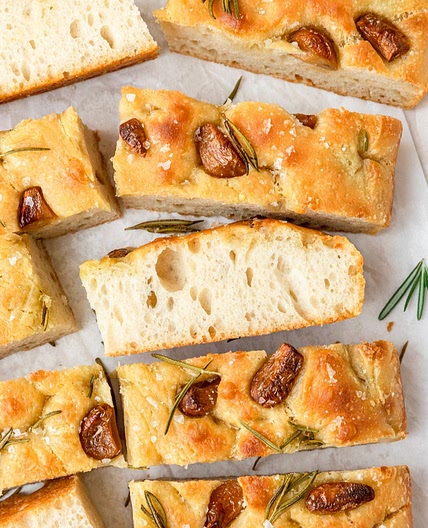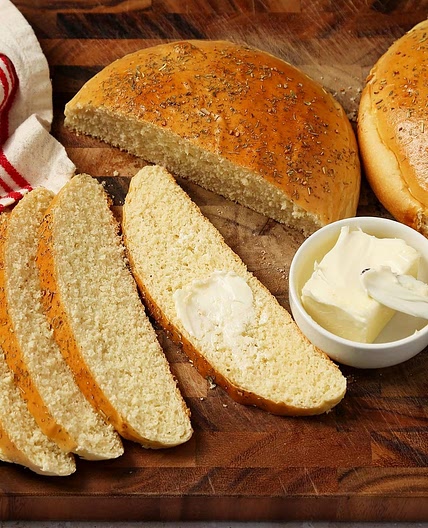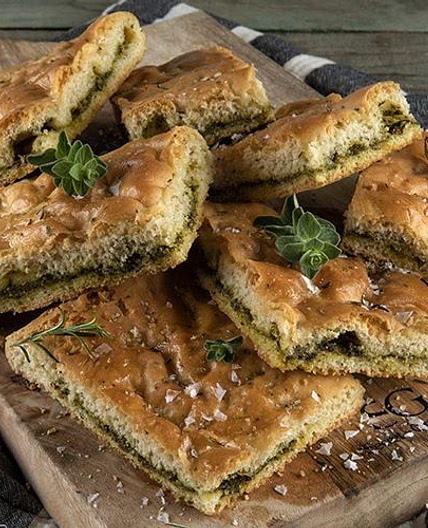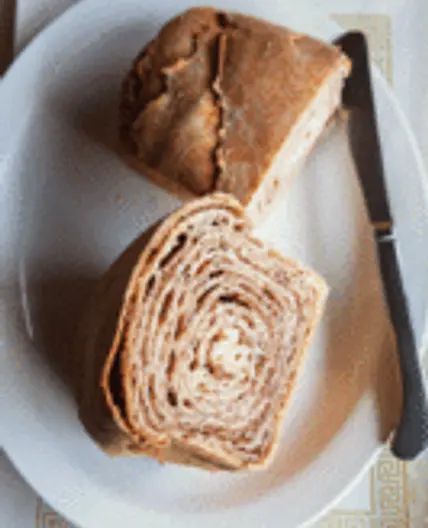Tomato-Olive Focaccia
Leave a note
By Gidjshiftee
Tomato-Olive Focaccia
To achieve the correct texture, the dough must be wet—so wet, in fact, it verges on a thick, yet pourable batter. Resist the temptation to add more flour than is called for. Shaping such a sticky, high-hydration dough by hand is impossible. Instead, the dough is gently poured and scraped into the oiled baking pan; gravity settles it into an even layer. If you have trouble finding Castelvetrano olives, substitute any large, meaty green olive. To slice the baked focaccia for serving, use a serrated knife and a sawing motion to cut through the crust and crumb without compressing it. For convenience, the dough can be prepared and transferred to the baking pan a day in advance. After it has settled in the pan, cover tightly with plastic wrap and refrigerate. The next day, prepare the toppings. Uncover, top the dough with the olives and tomatoes and let stand at room temperature for 45 minutes, then finish & bake as directed.
Updated at: Thu, 17 Aug 2023 00:05:37 GMT
Nutrition balance score
Unbalanced
Glycemic Index
72
High
Glycemic Load
23
High
Nutrition per serving
Calories264.5 kcal (13%)
Total Fat12.2 g (17%)
Carbs32.5 g (12%)
Sugars0.8 g (1%)
Protein5.1 g (10%)
Sodium578 mg (29%)
Fiber1.9 g (7%)
% Daily Values based on a 2,000 calorie diet
Ingredients
12 servings
Instructions
Step 1
In a stand mixer with the dough hook, mix the flour, yeast and sugar on medium until combined, about 30 seconds. With the mixer on low, drizzle in the water, then increase to medium and mix until the ingredients form a very wet, smooth dough, about 5 minutes. Turn off the mixer, cover the bowl and let stand for 10 minutes. Meanwhile, coat the bottom and sides of a large bowl with 2 tablespoons of oil; set aside.
Step 2
Sprinkle 1 teaspoon of salt over the dough, then knead on medium until smooth and elastic, about 5 minutes; the dough will be wet enough to cling to the sides of the bowl. Using a silicone spatula, scrape the dough into the oiled bowl. Dip your fingers into the oil pooled at the sides of the bowl and dab the surface of the dough until completely coated with oil. Cover loosely with plastic wrap and let stand at room temperature for 5½ to 6 hours; during this time, the dough will double in volume, deflate, then rise again (but will not double in volume again).
Step 3
After the dough has risen for about 4½ hours, heat the oven to 500°F with a baking steel or stone on the middle rack. Mist a 9-by-13-inch metal baking pan with cooking spray, then pour the remaining 2 tablespoons oil in the center of the pan; set aside.
Step 4
When the dough is ready, gently pour it into the prepared pan, scraping the sides of the bowl with a silicone spatula to loosen; try to retain as much air in the dough as possible. The dough will eventually settle into an even layer in the pan; do not spread the dough with a spatula, as this will cause it to deflate. Set aside while you prepare the tomatoes.
Step 5
In a medium bowl, use a potato masher to lightly crush the tomatoes. Scatter the olives evenly over the dough, then do the same with the tomatoes, leaving the juice and seeds in the bowl. If the dough has not fully filled the corners of the pan, use your hands to lightly press the tomatoes to push the dough into the corners. Let stand uncovered at room temperature for 20 minutes.
Step 6
Drizzle the dough with the remaining 4 tablespoons oil, making sure each tomato is coated. Sprinkle evenly with the oregano, remaining ¾ teaspoon salt and the pepper. Place the pan on the baking steel or stone and bake until golden brown and the sides of the focaccia have pulled away from the pan, 20 to 22 minutes. Cool in the pan on a wire rack for 5 minutes Using a wide metal spatula, lift the focaccia from the pan and slide it onto the rack. Cool for at least 30 minutes before serving.
Notes
0 liked
0 disliked
There are no notes yet. Be the first to share your experience!











